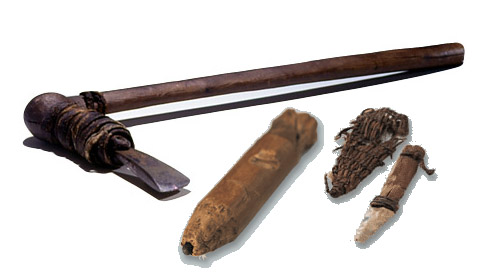Option A : Materials
 Introduction to
Introduction to 
 A.1 to A.7 and
A.1 to A.7 and  A.8 to A.10
A.8 to A.10
The Chalcolithic Age, an era between the Stone Age and the Bronze Age, involved the use of copper for tools but they were generally only possessed by the higher members of society and, unlike stone and bronze (which had yet to be discovered), were too soft to be in general usage. The word chalcolithic derives from the Greek words for copper and stone.

Özti's tools
One of the great examples of the Chalcolithic Age is Özti the iceman. He lived around 3200 BC and when his remarkably preserved body was discovered in the Alps in 1991 it was found that he had with him a knife with a flint (stone) head and an axe made out of yew with a copper head.
We have come a long way since man first used metal (copper) for tools. Option A covers the chemistry of materials and includes much about modern materials, for example, composites, catalysts, Kevlar® and liquid crystals as well as some more traditional chemistry such as the production of aluminium. It is relevant to students and contains a mixture of memory work, deduction from information and various different types of calculations.
The core part of this option basically gives an introduction to the classification of materials and their properties then looks at the principles underlying the extraction of metals from their ores. There is a separate sub-topic on catalysts that includes factors affecting their choice and modes of action. This is followed by sub-topics on liquid crystals, polymers and nanotechnology. The final part of the core is concerned with the environmental impact of plastics. The Additional Higher Level part of this option looks at superconducting metals and brings in X-ray crystallography, including the use of the Bragg equation. Condensation polymers and the environmental impact of heavy metals make up the last two topics.
In common with the other three options this option contains the common four strands of quantitative, analytical, environmental and organic chemistry. These are not equally represented though. The only reference to analytical in the core is Inductively Coupled Plasma Spectroscopy together with Optical Emission Spectroscopy and/or Mass Spectrometry. You can use the data obtained from these techniques to calculate quantitative amounts of trace metals in a sample but you are not required to fully comprehend the underlying theory of these spectroscopic techniques. Calculations are also covered by the use of Faraday's laws as well as the quantitative determination of trace amounts of metals. At Higher Level the calculations are more complex involving the use of the Bragg equation and units cells and equilibrium calculations with heavy metals involving solubility products.
Associated pages
A.1 Introduction to materials science
After studying this topic you should be able to use bond triangle diagrams for binary compounds from electronegativity data and evaluate various ways of classifying materials...
A.2 Metals and ICP spectroscopy
After studying this topic you should be able to deduce redox equations for the reduction of metals and
relate the method of extraction to the position of a metal in the activity series...
A.3 Catalysts
After studying this topic you should be able to explain the factors involved in choosing a suitable catalyst for a particular process and describe how metals work as heterogeneous catalysts...
A.4 Liquid crystals
After studying this topic you should be able to discuss the properties required for a substance to be used in liquid-crystal displays (LCD) and explain liquid-crystal behaviour on a molecular level...
A.5 Polymers
Describe the use of plasticizers in polyvinyl chloride and the use of volatile hydrocarbons in the formation of expanded polystyrene...
A.6 Nanotechnology
After studying this topic you should be able to distinguish between physical and chemical techniques to manipulate atoms to form molecules and describe the structure and properties of carbon nanotubes...
A.7 Environmental impact - plastics
After studying this topic you should be able to discuss why recycling polymers is an energy intensive process and compare the structures of polychlorinated biphenyls (PCBs) and dioxins...
A.8 Superconducting metals & X-ray crystallography (copy)
After studying this topic you should be able to analyse resistance versus temperature data for type 1 and type 2 superconductors and explain superconductivity in terms of Cooper pairs moving through a positive ion lattice...
A.9 Condensation polymers
After studying this topic you should be able to distinguish between addition and condensation polymerisation and complete and describe equations showing the formation of condensation polymers...
A.10 Environmental impact - heavy metals
After studying this topic you should be able to explain the use of chelating substances to remove heavy metals and deduce the number of coordinate bonds a ligand can form with a central metal ion...


